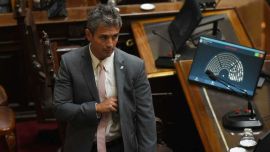Neuquén today becomes the second province in this series (after La Rioja) to jump the queue – by a fortnight, according to the ascending order of electorate magnitude defining the sequence – due to tomorrow’s elections whose repercussions could extend well beyond its Patagonian latitudes. This is not only by virtue of being the first decisive voting of this electoral year but also because the result will have its say in defining the future of Neuquén’s biggest (if not only) asset – Vaca Muerta shale. It would thus not be much exaggeration to say that the eyes of the world (or at least international, also investors) are on tomorrow’s provincial election.
All the main protagonists in a three-cornered gubernatorial race (which will not necessarily translate into a 30/30/30 result) are committed to the continuity of Vaca Muerta fracking but it is also necessary to read between the lines.
Cutral Có Mayor Ramón Rioseco (whose town, the birthplace of the picket movement he helped found, lies within the Vaca Muerta catchment area and where oil was discovered over a century ago) pledges to guarantee existing agreements but he is also the Civic Unity standard-bearer of a Kirchnerism which has hinted at Vaca Muerta as the silver bullet against the soaring tarifazo electricity and gas bills triggering so much popular discontent – all you have to do is nationalise Vaca Muerta, it is argued, and Argentines can go back to enjoying free energy (which does not explain how the surging production of the last couple of years would be sustained by pricing shale oil and gas at half their cost, a scheme which made the dead cow something of a dead duck in the years following its discovery a decade ago).
Horacio “Pechi” Quiroga, the Radical mayor of the provincial capital Neuquén City, obviously hails the energy boom but he also champions a national government which subordinates everything to the “zero deficit” pledged in last year’s agreement with the International Monetary Fund (IMF). Just over a month ago this fiscal urgency led the Mauricio Macri administration to slash gas subsidies by not only basing them on forecast rather than actual production (when the latter doubles the original estimates, surplus to the requirements of these summer months at least) but also limiting them to the half of the 16 agreements reached with the provincial government also endorsed at national level – thus prompting losses quantified at 5.6 billion pesos by Techint multinational, which is reviewing its investment plans.
No such inhibitions for incumbent Governor Omar Gutiérrez of the Neuquén Popular Movement (MPN), signatory of those 16 agreements and otherwise on civilised terms with Macri – if the comedian W.C. Fields never met a drink he did not like, it would seem that Gutiérrez never met an oil company he did not like, welcoming all and sundry regardless of fiscal, environmental, labour or other considerations.
Given that the MPN enjoys an unbeaten record since its creation in 1962, the defeat of Argentina’s most solid political machine would go beyond a nationwide backlash against recession to make this year’s elections truly unpredictable. Yet unlikely to happen. The most recent opinion poll gives Gutiérrez 31 percent with 27 percent for Rioseco, 23 percent for Quiroga and 7-8 percent for former three-term governor Jorge Sobisch, now running as a Christian Democrat – since these polls generally ignore the smaller communities where the MPN stranglehold is total after over half a century, the incumbent’s margin might well stretch to several percent with Quiroga (the beneficiary of polarisation) and Rioseco (beneficiary of the current bleak socio-economic scenario) fighting it out for runner-up.
If the Rodríguez Saá dynasty dominated last Saturday’s column on San Luis, Neuquén’s Sapags certainly deserve a paragraph. The founder of the dynasty was Canaan Sabbagh (1881-1987), a Lebanese Maronite Christian who emigrated to Zapala as one of that city’s founders in 1913 long before Neuquén (a national territory since 1884) became a province in 1955, but the key figure was MPN creator Felipe Sapag (1917-2010), who served five terms as governor between 1962 and 1999. Felipe Sapag was a lifelong Peronist but the then ban on that movement obliged him to found the MPN as a neo-Peronist provincial party in 1961 – but for that circumstance Argentina would today have six provinces always Peronist since at least 1983. The Sapags, who have always favoured accumulating power over money, have made Neuquén a byword for efficiency among the generally feudal backwaters alongside San Luis – health care in particular is considered exemplary although Vaca Muerta is starting to epose an outdated infrastructure.
Apart from tomorrow’s key gubernatorial race, Neuquén will be renewing its 35-seat legislature (12 MPN, four Victory Front, two PRO, two Radical, four left, eight minor provincial parties and three others) as well as town halls across the 16 departments. Apart from Quiroga’s Neuquén (231,780 inhabitants and founded in 1904) and its satellites of Centenario (34,421) and Plottier (33,600) and Rioseco’s Cutral Co (36,162, all figures in this paragraph from the 2010 census), the main cities are Zapala (32,355), San Martín de los Andes (28,599, founded in 1898), Rincón de los Sauces (19,398), Plaza Huincul (13,532), Chos Malal (13,132), Junín de los Andes (13 ,086, founded in 1883) and Villa La Angostura (11,063) with all towns smaller than Zapala (Victory Front) governed by the MPN. Cutral Có, Plaza Huincul and Rincón de los Sauces are energy production hubs, Chos Malal and Zapal are the main towns of northern and central Neuquén while the others are tourist centres in the scenic south featuring the famous Seven Lakes route with San Martín de los Andes the most beautiful.
All three senators (Lucila Crexell and oil workers trade unionist Guillermo Pereyra for the MPN and Senate Victory Front caucus leader Marcelo Fuentes) and two of the five deputies (the Victory Front’s José Ciampini and PRO’s Leandro López Koenig with the Victory Front’s Dario Martínez, the MPN’s Alma Sapag and PRO’s David Schelereth the legislators halfway through their terms) face the voters this year although not tomorrow. The senators should be re-elected but the tussle for the two Lower House seats stands to be a more even three-cornered fight than the gubernatorial race with the outcome perhaps hinging on the nationwide state of the economy next spring.
Tomorrow’s electorate will number 492,897 out of a population estimated at almost 638,000 in 2015 – a population literally growing by the hour because according to Production and Labour Minister Dante Sica (in an interview published in the January 12 edition of this newspaper) 22 families are moving to Neuquén every day on average. Thanks, of course, to Vaca Muerta – perhaps the key to Argentina’s future as much as Neuquén’s.























Comments